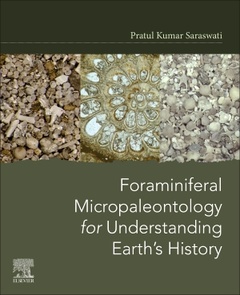Foraminiferal Micropaleontology for Understanding Earth’s History
Auteur : Saraswati Pratul Kumar

Foraminiferal Micropaleontology for Understanding Earth?s History incorporates new findings on taxonomy, classification and biostratigraphy of foraminifera. Foraminifera offer the best geochemical proxies for paleoclimate and paleoenvironment interpretation. The study of foraminifera was promoted by oil exploration due to its exceptional use in subsurface stratigraphy. A rapid technological development in the past 20 years in the field of imaging microfossils and in geochemical microanalysis have added novel information about foraminifera.
Foraminiferal Micropaleontology for Understanding Earth?s History builds an understanding of biology, morphology and classification of foraminifera for its varied applications. In the past two decades, a phenomenal growth has occurred in geochemical proxies in shells of foraminifera, and as a result, crucial information about past climate of the earth is achieved. Foraminifera is the most extensively used marine microfossils in deep-time reconstruction of the earth history. Its key applications are in paleoenvironment and paleoclimate interpretation, paleoceanography, and biostratigraphy to continuously improve the Geologic Time Scale.
1. Introduction2. Biology and calcification3. Morphology and classification4. Evolution and extinction5. The time-keepers of earth history6. The recorders of marine environment7. Geochemical proxies8. Deep-time climate reconstruction9. Isotope paleobiology and paleoecology10. Foraminifera – witness of the evolving earth
- Provides an overview of the Earth history as witnessed and evidenced by foraminifera
- Discusses a variety of geochemical proxies used in reconstruction of environment, climate and paleobiology of foraminifera
- Presents a new insight into the morphology and classification of foraminifera by modern tools of x-ray microscopy, quantitative methods, and molecular research
Date de parution : 06-2021
Ouvrage de 340 p.
19x23.4 cm
Thèmes de Foraminiferal Micropaleontology for Understanding... :
Mots-clés :
?Algal symbionts; Allopatric speciation; Biological pump; Biometry of foraminifera; Biostratigraphy; Boron isotopes; CLIMAP; Carbon budget in foraminifera; Carbon isotope excursion; Cellular ultrastructure of foraminifera; Chamber formation; Classification of foraminifera; Climate and evolution; Climate change; Cretaceous greenhouse; Deep-sea benthic foraminifera; Dissolution of foraminifera; Distribution of foraminifera; Dysoxic foraminifera; Eocene hyperthermal events; Evolution of larger benthic foraminifera; Evolutionary paleoecology; Foraminifera early evolution; Fusulinoidea; Gametogenic calcite; HMS Challenger; Infaunal foraminifera; Isotope depth ranking; Isotope fractionation; Isotopic evidence of photosymbiosis; JOIDES; K/Pg mass extinction; Larger benthic foraminifera; Last glacial maxima; Magnesium/calcium ratio; Marine carbonate; Mass extinction; Modeling of foraminiferal shells; Models of calcification; Models of speciation; Molecular basis of classification; Morphotypes; Neogene; Nutrient proxies; Ocean acidification; Ocean anoxic events; Organic flux; Oxygen and carbon isotopes; PETM; Paleoclimate; Paleogene; Paleontological resolution; Photosymbiosis; Planktic foraminifera; Planktic foraminifera depth stratification; Planktic foraminiferal zones; Preservation of foraminifera tests; Productivity; Proxies; Pseudopodia; Range expansion in foraminifera; Rate of calcification in foraminifera; Sea level; Shallow benthic zones; Stratigraphic resolution; Symbiont-bearing foraminifera; Sympatric speciation; Temperature calibration; Temperature proxies; Time resolution; Vital effect; Wall texture



